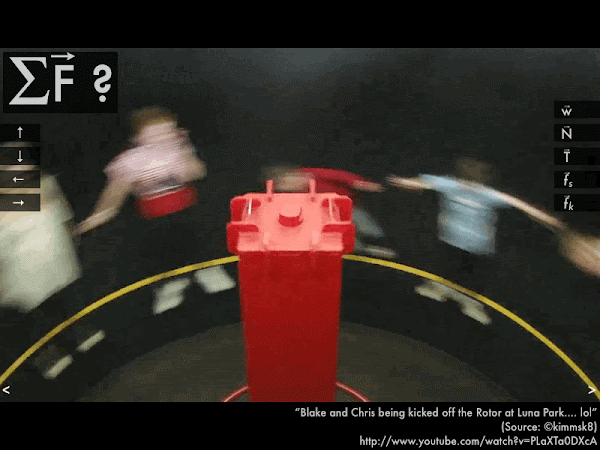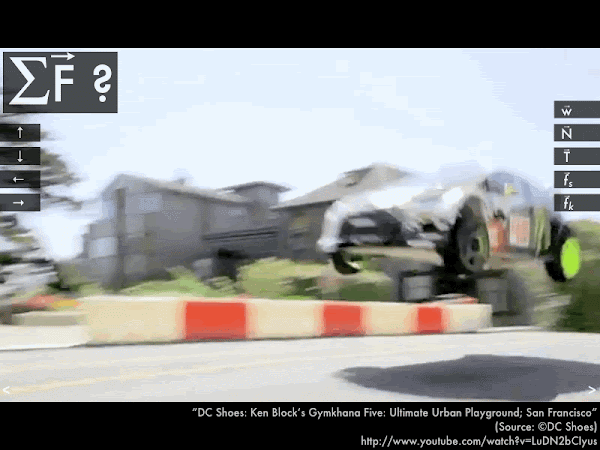 Why did the riders on the roundabout get flung off? What would have been needed for them to stay on the roundabout? Well, why is...those things? Because...physics.
Why did the riders on the roundabout get flung off? What would have been needed for them to stay on the roundabout? Well, why is...those things? Because...physics.First we'll look at the requirements for circular motion, and then we'll apply those concepts to several real-world examples of circular motion.
 Recall that circular motion is covered by Newton's second law. Even restricted to uniform circular motion (constant speed along circle), Newton's second law still applies, as the direction is continuously changing, and the acceleration a = v2/ralways points in towards the center.
Recall that circular motion is covered by Newton's second law. Even restricted to uniform circular motion (constant speed along circle), Newton's second law still applies, as the direction is continuously changing, and the acceleration a = v2/ralways points in towards the center. In fact, this is the requirement for uniform circular motion--in order to maintain constant speed along a circular trajectory, with acceleration directed in towards the center, the net force (the addition of all forces acting on the object) must be exactly equal to mv2/r, and be directed in towards the center.
In fact, this is the requirement for uniform circular motion--in order to maintain constant speed along a circular trajectory, with acceleration directed in towards the center, the net force (the addition of all forces acting on the object) must be exactly equal to mv2/r, and be directed in towards the center. Most simply we can satisfy this net force requirement with just one force. Here a mallet continuously taps inwards on a bowling ball, and as a result the bowling ball undergoes uniform circular motion. The net force (supplied by tapping) points inwards, which is along the centripetal ("center-seeking") direction.
No tapping, no inwards net force, and no uniform circular motion--the bowling ball then rolls at constant speed in a straight line, subject to Newton's first law. (Video link: "David and Alan hit a ball so that it travels in a circle.")
Similarly, pulling on a string can satisfy this net force requirement by pulling inwards on a donut, and as a result the donut undergoes uniform circular motion. The net force (supplied by the string) points inwards, which is along the centripetal ("center-seeking") direction.
(If the string breaks, then there would be no inwards net force, and no uniform circular motion, such that the donut undergoes free fall--subject to Newton's second law vertically, but Newton's first law horizontally, and thus would be seen moving in a straight line seen from above). (Video link: "Filippenko and the moon’s orbit demonstration.")
 What about centrifugal ("center-fleeing") forces? For the purposes of this course (limited to Newtonian physics in inertial reference frames), we'll consider centrifugal forces as being "fictitious forces," as someone undergoing uniform circular motion (such as this stuntman) would describe themselves as being flung outwards. However, analysis of the actual forces acting on that person undergoing uniform circular motion would in fact be inwards (here, supplied by the stuntwoman on the stuntman). It's perfectly natural to think about "feeling" centrifugal forces when personally experiencing uniform circular motion, but in applying Newton's laws, concentrate on the actual forces that act on you when undergoing uniform circular motion.
What about centrifugal ("center-fleeing") forces? For the purposes of this course (limited to Newtonian physics in inertial reference frames), we'll consider centrifugal forces as being "fictitious forces," as someone undergoing uniform circular motion (such as this stuntman) would describe themselves as being flung outwards. However, analysis of the actual forces acting on that person undergoing uniform circular motion would in fact be inwards (here, supplied by the stuntwoman on the stuntman). It's perfectly natural to think about "feeling" centrifugal forces when personally experiencing uniform circular motion, but in applying Newton's laws, concentrate on the actual forces that act on you when undergoing uniform circular motion.  Let's apply this centripetal requirement for net force to various examples of objects experiencing uniform circular motion.
Let's apply this centripetal requirement for net force to various examples of objects experiencing uniform circular motion.As the car and motorcycle both undergo uniform circular motion, what direction is the net force on them? Which force(s) contribute to the net force? (Video link: "Motorcycle vs. Car Drift Battle.")
As the woman (momentarily) undergoes uniform circular motion at the bottom of her swing, what direction is the net force on her? Which force(s) contribute to the net force? (Video link: "hanging rock rope swing bella.")
As the motor scooter undergoes uniform circular motion, what direction is the net force on it? Which force(s) contribute to the net force? (Video link: "WALL OF DEATH (homemade) the SCOOTER did it amazing.")
As the car (momentarily) undergoes uniform circular motion at the top of the loop-the-loop, what direction is the net force on it? Which force(s) contribute to the net force? (Video link: "Fifth Gear Loop the Loop.")
As a person undergoes uniform circular motion in this carnival ride, what direction is the net force (as seen from the side)? Which force(s) contribute to the net force? (Video link: "Blake and Chris being kicked off the Rotor at Luna Park.... lol.")
As the car (momentarily) undergoes (an approximation of) uniform circular motion careening over the top of this hill, what direction is the net force on it? Which force(s) contribute to the net force? (Video link: "DC Shoes: Ken Block’s Gymkhana Five: Ultimate Urban Playground; San Francisco.")
As the skateboarder (momentarily) undergoes uniform circular motion at the top of the loop-the-loop, what direction is the net force on him? Which force(s) contribute to the net force? (Video link: "Bob Burnquist Loop of Death.")










No comments:
Post a Comment